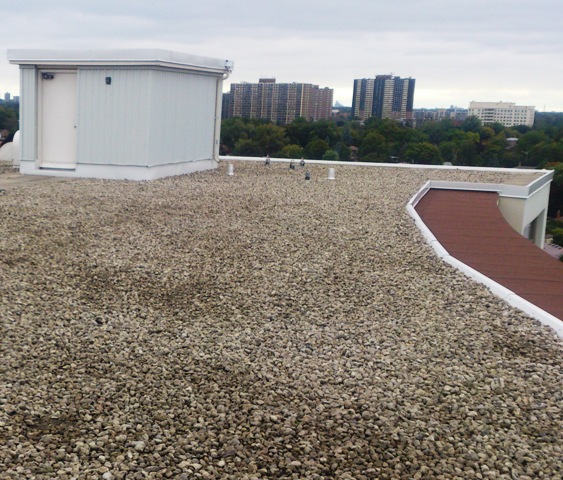

Built Up Roof - BUR
Built-Up Roofs have a long history and impeccable reputation in the industrial and commercial flat roofing industries. Although the investment may be greater than other roofing alternatives, the long term value of a built up roof system is outstanding. These roof systems are sometimes referred to as “tar and gravel roofs (although we don’t actually use tar as it’s a carcinogenic) and asphalt BUR is the most common type of flat roof system.
BUR systems generally are composed of alternating layers of bitumen and reinforcing fabrics that create a finished membrane. The number of plies in a cross section is the number of plies on a roof: The term “four plies” denotes a four ply roof membrane construction. Sometimes, a base sheet, used as the bottom most ply, is mechanically fastened. Built up roofs generally are considered to be fully adhered if applied directly to roof decks or insulation. The reinforcing fabrics also are called roofing felts or ply sheets.
.
The bitumen typically used in BUR roof systems is asphalt, coal tar or cold-applied adhesive. The asphalt or coal tar is heated in a kettle or tanker and then applied by mop or mechanical spreader. Asphalt is a petroleum product refined from crude oil; coal tar is derived from the distillation of coal. Cold-applied adhesives typically are solvent-based asphalts that don’t have to be heated in a kettle or tanker.
.
The materials used for built up roof systems include aggregate (such as gravel, slag or mineral granules), glass-fibre or mineral surfaced cap sheets, hot asphalt mopped over the entire surface, aluminum coatings or elastomeric coatings. Asphalt BUR is the most common type of flat roof at this time. It is made up of multiple layers of reinforcing plies and asphalt forming a redundancy of water proofing layers. The reflectivity of built up roofs depend on the surfacing material used. Gravel is the most common and they are referred to as asphalt and gravel roofs.
.
The Benefits from a Built-up Roofing System:
System Longevity
Each ply of a Built-Up Roofing system contains a mat of glass fiber reinforcement while most single-ply systems contain no reinforcement at all. When multiple plies are combined and positioned between layers of water-resistant asphalt, the result is a longer lasting roof. Easy and economical to maintain. And if necessary, can be repaired with conventional, time-proven materials, resulting in extended service life. Product and material improvements have enhanced an already high-quality system.
.
Limited Roof Movement
All roofs expand and contract, especially in the cold weather states. A Single-ply roof typically responds by elongating its infrastructure. Over time single-ply systems can lose their elasticity, resulting in buckling, ridges and splits. A Built-Up Roof, however, dramatically limits movement with a high tensile strength in excess of the recommended 200 lbs./sq.in. Fracturing is essentially all but eliminated, and the Built-Up Roof will last longer. A larger critical mass enables the roof to tolerate surface punishment.
.
Superior Water Resistance
It's simple, multiple layers of reinforcement offer more protection thus reducing the risk for leaks, whereas, a single-ply membrane only offers one chance at preventing a leak. Additionally, nothing compares to asphalt when it comes to making a roof water resistant. Asphalt is the glue that holds a Built-Up Roof together. It seals and protects the entire roof, delivering up to five times greater water-resistant thickness.
.
At Modern Roofing Inc. we have been installing commercial “built-up” roofing systems for over 30 years. Not only have we become the local experts on built-up commercial roofing but this type of roofing system has been around for over 100 years!
.
To get an estimate for your project or more information in regards to your roofing needs, please feel free to call us or submit the estimate form.
.
☎ 647-866-5964